ART DECO FESTIVAL
NORTHLAND STUDENTS
SAMPLE NAVY LIFE
NAVIGATOR ON RAN’S LARGEST SHIP

Navy at Art Deco


This will take time,



ART DECO FESTIVAL
NORTHLAND STUDENTS
SAMPLE NAVY LIFE
NAVIGATOR ON RAN’S LARGEST SHIP



This will take time,



World events serve as a reminder of why we as a New Zealand Defence Force and Royal New Zealand Navy remain focused on our combat capability and ability to respond to a range of commitments and military operations.”
2024 is underway, with the first couple of months reminding us all about some of the challenges we face domestically, regionally and globally.
We’re very fortunate to live in New Zealand, but we’re not immune to pressures including threats that can affect our way of life.
World events serve as a reminder of why we as a New Zealand Defence Force and Royal New Zealand Navy remain focused on our combat capability and ability to respond to a range of commitments and military operations.
Through our training we produce skilled personnel and capable leaders who work alongside international partners on a variety of complex security issues and activities.
As Commander Joint Forces New Zealand, I hear every day about the impact our sailors, soldiers and aviators are having while on operations.
Our contribution is varied and includes assisting with keeping commercial sea lanes open in the Middle East region, equipping Armed Forces of Ukraine recruits with soldiering skills they can take to the battlefield in Ukraine’s self-defence, and providing capable personnel to multinational peacekeeping missions.
In these environments, we’re operating with international partners and again this year we will continue to participate in large-scale training activities that enhance our relationships, maintain interoperability and put our skills to the test in a range of warfighting scenarios.
The RIMPAC Commanders’ Conference, which I attended in Wellington in February, carried out detailed planning for this year’s RIMPAC, the world’s largest international maritime exercise. RIMPAC 2024 will be the 29th iteration in the series and will take place in Hawaii midyear. The NZDF will be among participants at the joint exercises which cover a range of scenarios such as complex warfighting, maritime security operations, and humanitarian assistance and disaster relief responses.
Regionally and domestically, we continue to support our partners and other government agencies with deployable teams combating illegal, unregulated and unreported (IUU) fishing.
I have found it interesting to see how new technologies can add to the tools we have at our disposal when dealing with issues such as IUU fishing.
The RNZN has been trialling a 6.8 m Uncrewed Surface Vessel which has the potential to be used for fishery and border protection, or providing meteorological data. We’re talking to our agency partners in New Zealand about its possible uses, as it is trialled in Auckland Harbour and the Hauraki Gulf.
I wish you all well as we run into a busy and rewarding 2024.
He heramana ahau.
Rear Admiral Jim Gilmour
Commander Joint Forces



The Navy’s welcome return to the Art Deco Festival in Napier last month had the inescapable poignancy of their disaster relief activities in Hawke’s Bay exactly a year ago.
The festival, cancelled since 2021 due to the COVID-19 years and the devastation of Cyclone Gabrielle last year, regularly invites the Royal New Zealand Navy to commemorate the Navy’s service to Napier during the 1931 earthquake. HMS VERONICA happened to be in Napier on 3 February 1931, and after the 7.8 magnitude quake the crew went ashore to aid the city’s residents.
HM Ships DUNEDIN and DIOMEDE followed soon after.
In the colourful week-long Art Deco Festival, Napier pays homage to the period when the city rebuilt itself in the architecture of the time. People dress up in 1930s clothing and Navy personnel, wearing uniforms largely unchanged since the 1930s, blend in easily.
The Navy’s support from this time is all but gone from living memory, but what is very clear in Napier’s recent memory is the assistance from the Defence Force after Hawke’s Bay was devastated by Cyclone Gabrielle last year.
Under the name Operation Awhina, HMNZ Ships CANTERBURY, TE MANA and MANAWANUI berthed in Napier as part of Cyclone recovery operations. As well as transporting supplies, TE MANA sent crews ashore for clean-up activities.
MANAWANUI distributed supplies to cut-off communities along the East Coast, while CANTERBURY brought in supplies – including bridge building materials – from the South Island.
For this year’s festivities, HMNZS MANAWANUI returned to the city, while crewmembers from HMNZS TE KAHA, including Commanding Officer Commander Fiona Jameson, travelled by road to Napier. The city is TE KAHA’s ceremonial home port.
The personnel stamped their mark early. In the lead-up to the weekend, teams from MANAWANUI and TE KAHA put in some community work in areas still recovering from cyclone damage. TE KAHA’s team of eight visited a strawberry farm in



Eskdale, moving strawberry plants and sorting still-usable fenceposts from the flood debris. Elsewhere in Eskdale MANAWANUI’s team of 12, armed with lawn mowers and tools, cleaned up gardens, mowed lawns and helped with a kitchen clean-up at Linden Estate Winery.
Linda Patterson, one of the organisers in Eskdale, posted a “huge shout out” to the Navy crews. “It was hot, hard work and they made a huge difference to Pōhutukawa Drive and Linden Estate. They were wonderful and really gave the locals a boost.”
Saturday’s Vintage Car Parade featured the Royal New Zealand Navy Band leading the way from Clive Square to the Napier Soundshell, followed by marching Navy personnel. Senior Navy officers usually ride in a gleaming vintage car, but Commander Yvonne Gray, Commanding Officer MANAWANUI, opted for a different ride. Her crew were helping recreate an historic moment, riding on a trailer towed by a restored Fordson Model F Industrial tractor – the same one that transported HMS VERONICA sailors through devastated streets in 1931.
Following the vintage car parade Navy personnel accepted an invite to the Napier Branch of the Ex-Royal Naval Men’s Association of New Zealand. The club, which opened in 1957, was full of veterans and their families, and the combination – plus a formal ‘up spirits’ tot of rum – made for a cheerful engagement.
Club secretary Buzz Barham said it was very pleasing to have the Navy at the club. “You have come here to commemorate the earthquake in Napier in 1931 and now, we’re going through many of the same emotions a year after Cyclone Gabrielle. It’s fantastic to have you here”.
MANAWANUI’s Executive Officer, Lieutenant Commander Matt Gajzago, commented on the “remarkable” history of the club, built from the ground up by World War 2 veterans, including Buzz Barham’s late father, Johnny Barham.
Formal events that day included the Royal New Zealand Navy Band’s concert at the Napier Soundshell and TE KAHA crew conducting a formal Sunset Ceremony.
The most sombre part of the festival is the ringing of the bell of HMS VERONICA on Sunday. Following a church service at Waiapu Cathedral, attended by TE KAHA personnel, Napier citizens gathered at the Veronica Sunbay, a memorial on Napier’s foreshore, to witness the Veronica Bell being rung. Westshore Sea Scouts escorted the bell from Napier Museum and hung it in place, before Leading Logistics Supply Specialist Sam de Bueger stepped forward to ring the bell, in remembrance of those lost in the earthquake and a celebration to the courageous Navy relief parties.
Opposite page: The Royal New Zealand Navy Band warm the crowd up at Clive Square, before the Vintage Car Parade gets underway.
Commodore Mat Williams (left), guest, and LTCOL Stewart Dines, British Defence Adviser.
Sailors from HMNZS MANAWANUI and HMNZS TE KAHA march near Napier’s Soundshell ahead of the Vintage Car Parade.
Above: CDR Fiona Jameson, CO HMNZS TE KAHA, and guest, in a vintage car.

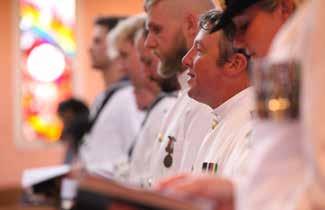
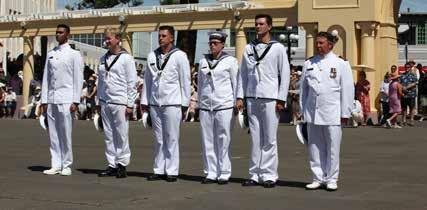
Commodore Mat Williams, attending as the senior representative of the Navy, noted that the people of Napier now regrettably know the feeling of being part of an emergency response. Today, the ships are different and both men and women come ashore, he says.
“But it is the same values and work ethic that we see today. It is our people, not our ships, where the true capability lies.”
Napier mayor Kirsten Wise says Napier’s relationship with the Navy is a long and enduring one.
“The key role that the Navy played in the 1931 earthquake, saving hundreds of lives, when they with the community to try and make sense of this natural disaster.

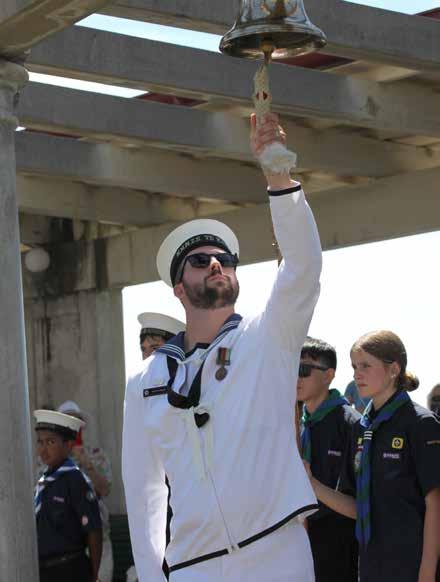
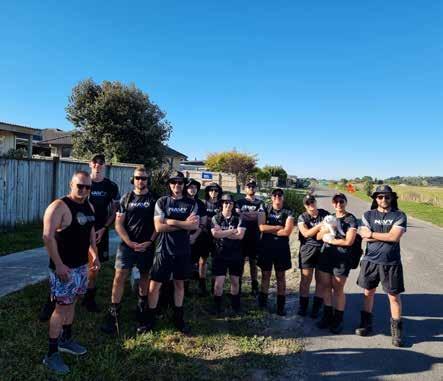
It is the same values and work ethic that we see today. It is our people, not our ships, where the true capability lies.”
– Commodore Mat Williams
Opposite page: CDRE Mat Williams speaks at the Veronica Memorial.
Ship’s Company from HMNZS TE KAHA attend the Art Deco Festival Sunday church service at Napier Cathedral. CPOSCS Konrad Cook stands with his crew during the hymns.
Sailors and officers from HMNZS TE KAHA stand as a prayer is offered to those lost in the 1931 Napier Earthquake disaster.
Sailors and officers from HMNZS TE KAHA and the Royal New Zealand Navy Band pose with Air Deco devotees prior to the Veronica Bell ceremony at Napier’s Veronica memorial.
Top: LLSS Sam de Bueger, HMNZS TE KAHA rings the Veronica Bell.
Below: Personnel from HMNZS MANAWANUI help with clean-up at Linden Estate.
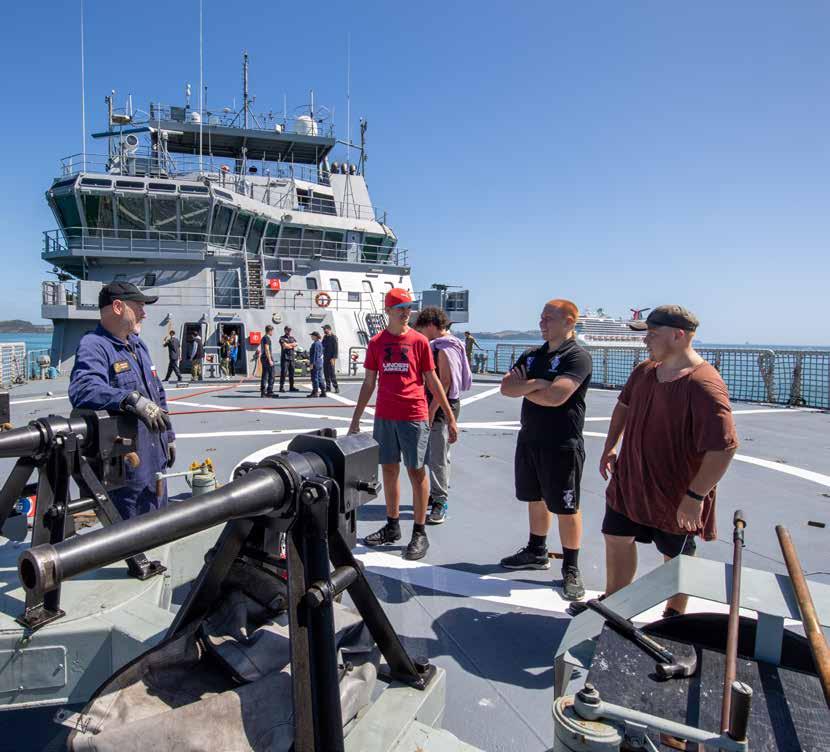
Hi-tech capability combined with Navy hospitality when HMNZS MANAWANUI hosted senior secondary school students for a day during Waitangi commemorations last month.
The outing, coordinated with Defence Recruiting, involved 18 students who had expressed interest in the New Zealand Defence Force as a career. Previous outings, called ‘Ahoy Waitangi’, have run since 2018 but involved primary school pupils.
Ensign Jess Andrews, on board MANAWANUI, says they transferred the students by seaboat to the ship, positioned adjacent to the Waitangi treaty grounds.
“After a welcome from the Commanding Officer they were given a general tour, then a damage control demonstration on the flight deck to show them how that works. They had a go with a variety of damage control equipment, including fire hoses.”
Following lunch the students were split into three groups and taken to different stations on the ship. “Members of the ship’s company were able to introduce their trades to the students and explain what they did on the ship. The students got to see different work places in a ship and ask questions about Navy trades.”
She says they wanted to expose the students to the variety of roles in the Navy. “It might give them some ideas as to what they’d like to do if they joined.”
The ship was using ‘dynamic positioning’ to hold its position, where a computer coordinates MANAWANUI’s various propulsion systems to hold an exact spot on the water, even in rough conditions.
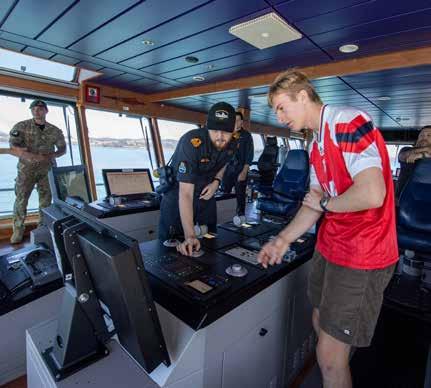
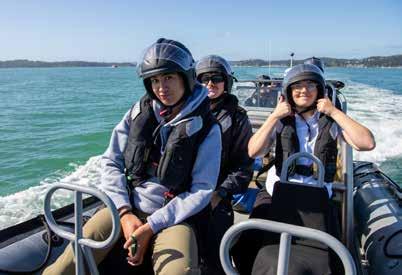

Tutor Graeme Patu, from People Potential in Whangarei, says that was an eye-opener. “That was almost science fiction, how the ship can sit there without an anchor.”
He says the outing provided great knowledge about what people did on Navy ships. “We brought someone who is really interested in joining the Navy as an electrician. But everyone asked lots of questions on the day and they found it really helpful. And the food was the best. I’d heard the Navy has always got the best food.”
Cadet Flight Sergeant Ripeka Joyce, 17, from Kaikohe, says her mother signed her up for the visit. “That stood out for me, how a ship can stay in one place even in big waves.” She is currently with No. 25 Squadron Air
Training Corps and is considering a future with the Defence Force.
“I want to do something with lots of opportunities. It was good to talk to the sailors, they were amazing help.”
Kelly Stacey, from Kaitaia, says her favourite experience was learning how to use a fire hose. “Everyone on the ship is trained to fight fires, which I thought was really cool. It was a great experience, getting to see what a day in the life of Navy personnel is like.”
Chief of Navy, Rear Admiral David Proctor, met the students before they embarked. He told them he was in his 38th year in the Navy.
“I would do it all again. I’ve had a really good time, I’ve been provided a whole lot of good training and I’ve had some fantastic opportunities.”



What’s not to like about serving on board HMAS ADELAIDE?



Lieutenant Commander Jerry Kemp RNZN says he feels very blessed to practise his trade aboard the Royal Australian Navy’s largest and senior ship.
LTCDR Kemp is the Navigating Officer of the 231-metre Landing Helicopter Dock ship, having posted on board in December after completing the year-long Principal Warfare Officer course at HMAS WATSON in Sydney. He was awarded dux of the Advanced Navigation course (PWO N+), and he’ll likely remain on board ADELAIDE until December 2025.
Originally from South Africa, LTCDR Kemp moved to New Zealand in 2002, first to Wairarapa and then Auckland’s King’s College as a boarder. He joined the Navy in 2005 as a Seaman Combat Specialist, leaving in 2007 to start university studies. He rejoined as an officer in 2010 and completed his studies under the Navy’s Chatham bursary scheme, then graduated from officer training as a Supply Officer. In 2016 he changed trades to Warfare Officer. You would think that on a ship as large as the ADELAIDE that there would be more than one Navigator or maybe a deputy Navigator but that isn’t the case. It’s just him.
“I’m lucky, though, I’m part of a very big team. Our bridge structure and routine is like any other warship. There is myself as the Navigating Officer, the Officer of the Watch (OOW) which may include an assistant (AOOW), a Quartermaster (QM) and a Bosun’s mate (BM). We have a proud methodology in ADELAIDE of
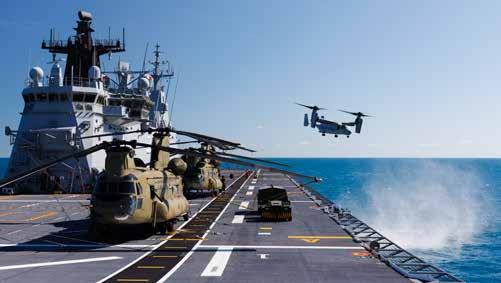
focusing on training, and we support the training establishments ashore and take on trainees wherever possible. The last time we went to sea, we had an extra 27 OsOW to provide seagoing experience to and assist them in gaining a platform endorsement.
“We all need to work closely together to ensure the ship is able to achieve all the tasking set for it over the year. It could range from mess dinners alongside, catering for 400 people, or conducting amphibious landings on a beach with multiple landing craft and a range of helicopters utilised on board.”
As Navigator he’s got some challenges coming up. “ADELAIDE is often referenced as a 50-story apartment block on its side, capable of launching four landing craft and eight helicopters near simultaneously.”
“ADELAIDE really has a great crew, very welcoming and supportive. Everyone wants to do their best and as the senior ship of the RAN we all do our best to lead by example to ensure excellence but to also make sure we are available to the rest of the fleet to guide, mentor and assist where ever we can.”
The Australians operate very similarly to New Zealand. “It’s great we can achieve an almost seamless transition from one platform to another. I love working with the Aussies. Not only are they a world class Navy but they are also experiencing some major changes and enhancements to their capability in support of the Australian Defence Strategic Review. It’s an exciting time to be here.
“Like us, they are experiencing challenges in retention and recruitment and like us, they are a bunch of very capable individuals, doing their very best every day supporting and protecting their national interests.”
There is one quirk he’s noticed. “One that always gets me is not only do they have more acronyms than we do, but they do this funny thing where they don’t say the letters of the acronym but instead turn the acronym into a word.”
His advice to someone looking at a Navy career boils down to three things, he says.
“You will be pushed hard to be the best version of yourself. This will take time, patience and hard work is essential.
“Every two to three years you can post in to a range of vastly different opportunities ranging from watchkeeping at sea, to being part of the Capability Branch or posting on operations anywhere in the world.
“And, when you’re sitting with your civilian mates at a dinner table, can they say that today they hunted a submarine, coordinated aircraft to a target, berthed a warship in a foreign port, or conducted amphibious operations? Can they say that every day they make a positive difference to New Zealand’s interests?”

A team of four Navy personnel ensured a diplomatic kaupapa in Washington DC was an event to be remembered.
In October, Leading Electronic Warfare Specialist Tilah Riri, Leading Chef Sand Wood, Able Chef Hinekatukura Magner-Macdonald and Chief Petty Officer Communication Warfare Specialist David Tapene travelled to Washington DC to assist with the New Zealand Embassy’s Defence Reception.
The annual function, with around 300 international guests, is meant to showcase New Zealand culture to the wider Defence community in the city.
LEWS Riri, with the Māori Cultural Group at Te Taua Moana Marae, says the request came out of the blue. “I thought, wow, what an opportunity. To go to Washington DC and do something so dear to our hearts –this is huge.”
She says the Defence Reception is a chance for New Zealand to show off its culture. She and CPOCWS Tapene, the marae manager, handled the
cultural side, coaching and mentoring the haka pōwhiri to the NZDF personnel posted in Washington. Meanwhile, the two chefs prepared a spread of New Zealand food.
“I did the karanga and haka pōwhiri, and David did the wero (challenge).”
She says the reaction was amazing.
“Everyone loved it. The Chief was highly sought after for conversation afterwards – everyone wanted to talk to him, ask him what he was doing and how the wero worked. People were really interested in our culture.”
She says it was the trip of a lifetime. “Who gets to go to Washington DC and share your culture? The highlight for me was working with our people and seeing how people appreciated our culture and appreciated us being there. And being able talk to people from different countries, who wanted to know about our Navy and how much we do in the world. I absolutely loved that.”

LCH Wood says he had no hesitation about saying yes when asked if he could go. When he and ACH Magner-Macdonald got there, they joined forces with the New Zealand Ambassador’s Executive Chef to do the preparation, and then on the day were joined by three assistant chefs for the cooking.
“We did our best to do some Kiwistyle food, including a deconstructed pavlova and lamb racks.”
He says he came prepared to work and the event was well within their capabilities. “My advice to other chefs is, if you get asked to travel and do something like this, don’t be afraid to say yes. Where else are you going to get the opportunity to go overseas and cook for an ambassador?”
In a thank-you letter to Commodore Andrew Brown, Deputy Chief of Navy, Defence Attaché Brigadier Michael Shapland DSD said the Māori cultural support was exceptional. “The pōwhiri was the highlight of the evening with guests commenting on the impact the ceremony had on them.”
He praised how well the two chefs were able to assimilate into a new environment, working with the New Zealand Ambassador’s Executive Chef to cater the event.
“The Defence Reception is an outstanding event made even better by the participation of servicemen/ women from New Zealand.”
The pōwhiri was the highlight of the evening with guests commenting on the impact the ceremony had on them.”
Medics in the New Zealand Defence Force can opt to become fully-qualified paramedics, thanks to study pathways offered by the Auckland University of Technology.
Three Navy medics, Leading Medic Laura Salmon, Leading Medic Courtney Davies and Petty Officer Medic Kesia Coutts fitted part-time study with their Navy duties to achieve their Bachelor of Health Science in Paramedicine from AUT in December.
The trio had completed their Defence medic training in 2019, which took them three years of training and study at the Defence Health School at Burnham Military Camp in Christchurch. The School has two intakes a year.
The degree is a self-lead option for Defence medics on completion of their time at Defence Health School.
LMED Laura Salmon said when they graduated in 2019 they were military medics with no civilian qualifications.
“But since then, the School has taken up a pathway with AUT, so we were able to get our training retrospectively recognised through recognition of prior learning.”
They were able to get 14 of the 24 papers required for the Bachelor of Health Science Paramedicine crosscredited. They had to complete the remaining 10 papers to get the degree.
“We started studying part-time in 2021, doing two papers a semester with the support of our units.”
That had its challenges, with the medics being posted to sea. Those serving as medics in Inshore Patrol Vessel HMNZS TAUPO were slightly better off, as it stayed close to shore and got better reception.
“In our final semester we had to conduct various ambulance shifts. We were given days off as study leave so we did not have to use our annual leave for our studies. These ambulance shifts were a highlight as it gave us great exposure to many of the emergency medical conditions the Navy has trained us in, but aren’t as common in the Navy environment.”
She says staff at AUT were very supportive. “They understood we were in the military and sometimes the Navy had to come first. They extended deadlines if we were away, changed exam dates to suit and let us conduct some exams on base so we didn’t have to travel out to campus.”
She says it was challenging to fit in their full-time roles as medics with part-time study. “We think it was something worth doing. It has been great professional development, which will open up doors externally.”
Staff Sergeant Kelly Whittle, Senior Instructor Defence Health School, says their new pathway with AUT now includes 18 months of AUT study at Burnham, with AUT lecturers based at the School. Medics can now obtain a Diploma in Paramedic Science, then a Graduate Certificate in Health Science. It means the training programme has cut from three years to two.
“They will have more than enough training and background to be an NZDF medic, but the degree is a great option if they are interested in further study. They have approximately five years to complete it once enrolled.”

1. AMUS Daniel Reshtan, saxophonist with the Royal New Zealand Navy Band, and LS Chelsea Alexi, guest clarinettist, Canadian Armed Forces, at Waitangi.
2. CDRE Andrew Brown, Deputy Chief of Navy, presents LTCDR Zoe Brangwin with her RNZN Volunteer Reserve Decoration (VRD) and 1st clasp.
3. LPTI Kiwi Tipoki prepares the new arrivals of intake BCT 24/01.
4. CDRE Andrew Brown presents WOMT(L) Howie Rait with his 4th clasp to his RNZN Long Service and Good Conduct Medal.
5. LSTD Andre’a Falchi gets his rig ready for Royal Guard duties at Waitangi.
6. WOMED Greg Staines, Command Warrant Officer HMNZS TE KAHA, pose for photos with the public during the Art Deco Festival.
7. LHST Evan Teao, HMNZS CANTERBURY, during the Auckland Rainbow Parade.
8. Aboard HMNZS MANAWANUI, POWT Matthew Poyntz prepares a saluting gun for firing during Waitangi commemorations.
9. MID Lucia West and OMTO June Paing, currently undergoing Naval Reserve Common Training 24/01.
10. LT Richard Mathers chats to veterans at the Napier branch of the Ex Naval Men’s Association of New Zealand.
11. Paddy Baker is promoted to Commander at Defence House.
12. WODR Lance Graham, Warrant Officer of the Navy, meets with his Australian counterpart, WO Andrew Bertoncin, Warrant Officer of the Navy (RAN).
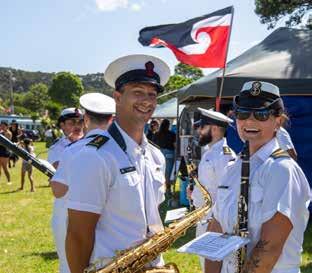

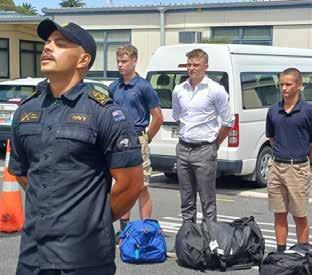














For personnel deployed for several months, a Defence Force psychologist will meet with them before the trip home.
On board HMNZS AOTEAROA, Lieutenant Commander Ryan Hissong, Navy psychologist, is having one-onone sessions with members of the Ship’s Company.
“It’s a chance for the personnel to reflect on the deployment, and open up if they want to. What have they learned about themselves? Learned about the job? What have they taken away from the experience? What are they struggling with? Are they able to step away from the deployment, draw a line in the sand, decompress? Do they need support? How is the family?”
In December AOTEAROA returned to New Zealand after a five-month deployment to South East Asia, with LTCDR Hissong boarding the ship for the final leg from Sydney to Auckland. It’s his job, working with another psychologist, to conduct individual Return to New Zealand Debriefs with each member of the crew.
For personnel deployed for several months, a Defence Force psychologist will often meet with them before the trip home “The psychologists are triservice. It could be for the contingent in the United Kingdom, training the Ukraine soldiers, or it could be for a Navy deployment like AOTEAROA.”
Following the sessions, it’s the psychologist’s job to provide a backbrief to Heads of Department and Command. “We give them some high-level themes, so they can use it to inform their practice and management.”
It can be a common perception that land-based missions are the harder, grander deployments. “But the realities of maritime deployments are that you’re operational all the time. It’s a different world out there, you’re isolated and if you’re not asleep you’re probably working – and perhaps not sleeping as much. It’s a high-demand workplace, and the Navy is short-staffed. You’ve got all these diverse people in a floating city, with all that complexity and the interpersonal dynamics that result. And then there’s the cumulative effect on families back home.”

Unlike a land-based deployment, the sailors go back to their mission after the session. “They’re not quite back yet.” And private spaces in a ship can be tricky to secure. “I was very grateful to the command team on AOTEAROA, prioritising space for us reflects the importance they place on the process.”
He says it is an amazing service offered to Defence Force personnel. “It’s no secret that historically militaries haven’t done a great job looking after people coming home from deployments. But the fact that New Zealand does this is one reason why I’m in the Defence Force.”
LTCDR Hissong, who is originally from New York State, is new to the Navy, joining in mid-2022. He worked as a behavioural psychologist in New Zealand for many years, in the health and disability space. Increasingly frustrated with the challenges and limitations in his work, he took an interest in organisational psychology. “For me it’s all about building systems that set people up for success. That is, to perform at their best, but also to work sustainably. And the best place to practise that is in the Defence Force.”
He met the former Navy head of psychology at a recruitment event and it went from there. He was in the Junior Officer Common Training (JOCT) intake 22/02 and graduated in December 2022.
“I never thought this was a possibility at this stage in my life,” he says. “Is it crazy for a guy pushing 40, with two kids at home, to do JOCT?
My partner and I have a two-year-old and a four-year-old. At the time the youngest was only six months. I think she thought I was out of my mind initially, but over time she began to see the value behind it and I’m very grateful for her support to take a chance on something different. It’s been one of the best decisions we’ve ever made!”
The Defence Force definitely ticked all the boxes in terms of his profession. “There’s a wide variety of different psychological tasks you can do in the Defence Force, much broader than other roles in psychology. There’s also a lot of other cool stuff you get to do in this job, like travel, damage control and firing a MARS-L rifle. It was a bit of an adventure. The other thing was, I grew up playing ice hockey and my first career was as a professional ice hockey referee. I really missed that high performance aspect of my life.”
For me it’s all about building systems that set people up for success. That is, to perform at their best, but also to work sustainably. And the best place to practise that is in the Defence Force.”
He has been the Head of Navy Psychology since December.
He says it is a real privilege to sit with sailors, soldiers and aviators and hear their stories. “We hear all the associated experiences, challenges, triumphs and everything in between, some of which they might not even share with their oppos or whānau.”
Psychologists also deliver predeployment briefs, which could involve a family night to explain what to expect with their loved ones being away.
“I often reflect on how incredible the commitment it is, and the associated sacrifices that these people make for our country - what a unique privilege it is to be keepers of all these stories and be able to support those that do so much for everyone else.”

Lieutenant Commander Chetan Sawyer has taken command of what is technically the Royal New Zealand Navy’s largest ‘ship’ – HMNZS NGAPONA.
On 9 December 2023, LTCDR Sawyer become the Commanding Officer of the Auckland-based reserve force unit, taking over from Lieutenant Commander Nigel Heslop.
In numbers, the ship's company fluctuates between 400 and 500 personnel.
LTCDR Sawyer joined the RNZN in 1996 and served for eight years. He cites a particular highlight as Executive Officer of dive tender HMNZS MANAWANUI (III), under
then Lieutenant Commander Garin Golding. At the time he figured it could take years before he became a Commanding Officer, but three months after he left, Project Protector was announced, which went on to create HMNZ Ships CANTERBURY, WELLINGTON, OTAGO and four Inshore Patrol Vessels.
In retrospect, he realises he would have probably gotten a ‘drive’ sooner if he stayed. “But I wanted to see a bit more of the world,” he says. He worked on cruise ships for the next 20 years, and visited every continent on the world, apart from Antarctica, and has been on several world cruises. In particular he enjoyed the tempo with three months on and three months off which allowed him time to build a house in the Bay of Islands.
In the last ten years, now with a wife and family, the novelty of a two-day commute to the UK for work lost some appeal, and he started consultancy work. In a complete full circle, he is now involved with the operational

release of the Navy’s latest ship called MANAWANUI (IV), the Dive Hydrographic Vessel.
All reserve forces units are unique, he says. They are all conduits for ex-regular force personnel but NGAPONA, being in Auckland (and a sub-unit in Tauranga) is particularly noted for this. It’s a talent pool the Navy can make use of.
“We have a lot of skills and we’ve got people everywhere. Quite a few are ‘strefies’ (STRFE – Short Term Regular Force Engagement) and they could be posted to headquarters, ashore in Devonport or on ships. We’ve had our people overseas at exercises such as RIMPAC or Talisman Sabre, doing operational testing, or posted ashore to support units. There would be few parts of the Navy that haven’t had someone from our unit at one time or another in recent years.”
For those interested in international travel, there are several opportunities with NGAPONA personnel participating in both operations and peacekeeping roles in Asia and the Middle East.
The unit’s regular events including attendance of Anzac Day, Armistice Day Sanders and HMS NEPTUNE commemorations. NGAPONA has a centenary coming up on 11–13 October, which will include a charter parade in Auckland. Last year the unit travelled to Cambridge for an Armistice service, providing a RHIB and personnel for demonstrations on Lake Karapiro.
LTCDR Sawyer is a fan of this kind of visibility. “I joined the Navy because an Australian Navy ship came into Whangarei. My father took me around and I was hooked on a Navy career from then on. Ship visits are where we need to go. When they’re at sea, they contribute to recruitment. People come on board, they see these role models, they want to join.”
All reserve forces units are unique, he says... It’s a talent pool the Navy can make use of.”

Since arriving in Antarctica on October 16th, I’ve had a multitude of once-in-a-lifetime experiences and had the pleasure of meeting some truly fascinating individuals during my six-month deployment.
The initial week tested my resilience with wind chill temperatures plummeting to as low as -30 degrees, prompting me to recognise the importance of having an abundance of Extreme Cold Weather (ECW) gear at the ready. Despite the harsh conditions, I’ve explored pressure ridges outside Scott Base, sped across the sea ice on a snowmobile, paid a visit to Shackleton’s Hut, and marvelled at seals navigating the icy terrain while penguins waddled nearby. McMurdo’s doorstep is home to Observation Hill, which showcases a 360-degree view of Mt Erebus, the Ross Island Sea, and the neighbouring Scott Base, creating a breathtaking backdrop for the local hikes, including Castle Rock Loop and the Armitage Trail.
Embracing the unique culture at McMurdo has been a highlight, resembling life on ship with a shared purpose of supporting science and upholding the Antarctic Treaty, and
participating in activities like the USAP Mass Casualty Incident (MCI) team and the Ross Island Yacht Club’s engaging presentations. The absence of Wi-Fi in most areas has unexpectedly become a blessing, freeing us from the grip of our phones and fostering a vibrant atmosphere of social interaction, from lively karaoke nights to competitive pool tournaments, and entertaining station-hosted events and social clubs. Weekly science talks have been enlightening, unveiling the remarkable discoveries happening in Antarctica, spanning from climate change studies to NASA’s exploration of the life cycle of interstellar gas in our Milky Way and the examination of sea ice nearly a million years old.
The recent arrival of the icebreaker vessel USCGC POLAR STAR in our Antarctic backyard signals a crucial phase in our deployment, enabling the berthing of our resupply vessel and a tanker ship at the ice pier in the upcoming weeks. The supply department, bolstered by a fiftyperson strong Ship Off-load team, is poised for round-the-clock operations in two shifts, ensuring seamless supply chain movements while the resupply vessel is alongside.
Undoubtedly, this deployment stands as the highlight of my Naval career thus far, and the anticipation for what lies ahead only intensifies as the team navigates through this unique and extraordinary experience in Antarctica.

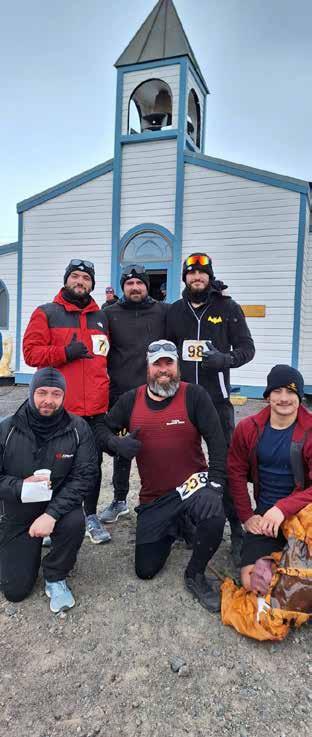
The New Zealand Defence Force’s new Pan Asian Network (PAN), launching last month at RNZAF Base Auckland, is intended as a support platform for the Defence Asian community and a connection for NZDF leaders who want to better support staff and colleagues of Asian ethnicity.
The launch on 9 February at RNZAF Base Auckland, timed with the start of the Lunar New Year, attracted sailors, soldiers, aviators and civilians for a meet-and-greet and morning tea, with speakers sharing personal journeys and senior leaders voicing their support.
The network’s creator and lead, Squadron Leader Nash Alur, shared his passion for creating a safe space for Pan Asian personnel and civilians. He was inspired by his own journey of fitting into New Zealand as an Asian and joining the Defence Force.
“As much of a New Zealander as I feel, there are differences,” he says.
“We come from completely different cultures and upbringings and I needed support around me to make the most of those differences.”
When he joined the NZDF, there were times when he wanted someone to talk to about the subtle things that only another Asian might understand.
“But there were very few of us around to begin with and I also did not feel comfortable to have those conversations, preferring to just try and fit in as best as I could. So I carried on and thought I would figure it out on my own.
“Years later I asked myself: if I as leader found this a challenge, how would a sailor, soldier, aviator or a civilian feel they could have those conversations or bring their whole identity to work?
“That was what got me thinking about forming this initiative. I talked to others and realized there was a need.”
He says it was not about people expressing concerns to him, but they were appreciative and grateful that such a network now exists.
“It’s about being proactive and having a representative voice to ensure Asian members within the NZDF can have the best lived experience. This in turn should benefit the NZDF through retention, recruitment and community awareness.”
He says this network could develop in many directions, but it had to start with honest conversation. “This is a safe community for Asians to have that conversation.”
Director of Diversity and Inclusion, Ms. Nina Russell, emphasized the importance of employee-led networks in enriching positive employee experiences.
In a video message, Mervin Singham, the Chief Executive of the Ministry of Ethnic Communities, conveyed his congratulations to SQNLDR Nash Alur on his leadership and to the NZDF on the launch of the network.
He spoke of his personal insights and experiences of the importance of employee networks such as this.
“Diversity of any workforce is just a fact – but making diverse employees feel genuinely included, that’s a choice every organisation has to make,” he told the audience.
SQNLDR Alur is supported by Lieutenant Commander Prasad Chavan and Staff Sergeant Lanka Ge as the Royal New Zealand Navy and NZ Army representatives.

LTCDR Chavan says he was surprised by the number of people who attended. “The turnout and the networking opportunity provided by the event just enforced why this network was needed for the NZDF.”
He says the network has huge potential to add significant value to the NZDF across recruiting, retention, support services, representational duties and inclusivity.
“When a young sailor, soldier, aviator or officer from the Asian community joins the organisation, they will know that there is an employee-led network for them. The network will contribute towards the NZDF becoming a more inclusive organisation.”
SQNLDR Alur says by the end of this year they want to have a formal committee and representation across the camps and bases, with future online and off-line events, and plenty of celebration around cultural events.

Leading Combat System Specialist Hailey Gibbons recounts her Antarctica experience aboard icebreaker POLAR STAR.
I was one of two Royal New Zealand Navy personnel invited to deploy on board the United States Coast Guard Cutter POLAR STAR for its summer mission to McMurdo Sound.
Myself and ASCS Cassidy Rangiahua joined the ship in Hobart, Tasmania. The POLAR STAR had originally set out from Seattle, Washington State, tasked with its yearly mission to cut a channel in the ice that surrounds Winter Quarter’s Bay, making the American base McMurdo – and New Zealand’s nearby Scott Base – accessible for restocking and refueling vessels.
POLAR STAR has the ability to break ice four metres thick while travelling at seven knots, or up to seven metres thick while backing and ramming. It does this with the aid of three Pratt and Whitney Diesel FT4A-12 Marine Power Pac Gas Turbines, which combined produce a total of 75,000 horsepower, and consume a whopping 60,000 gallons (227,000 litres) of diesel in a 24-hour period.
I was told this year we would face 33 miles (53km) of ‘fast’ ice (ice that is fastened to the mainland) and some unseasonably cold sea temperatures. A captain of a refueling vessel we later escorted told me it was some of the worst ice conditions seen since the 1980s.
Once the channel is open, 65 NZDF personnel based at McMurdo and Scott Base work alongside civilians and American military to support operations down on the ice.
POLAR STAR operates with a crew of approximately 150 but can accommodate up to 180 personnel. The remaining positions on board can get filled by sea riders, divers, civilian specialists and scientists. Almost every aspect of the ship and her capabilities are open to the sea riders. Core crew will facilitate new experiences, teaching opportunities and assist with any personal goals you might have.
I found the crew welcoming, knowledgeable and supportive. I dedicated some time with the ice analyst, learning about the ice conditions we were operating

in and the different stages of ice development. I learned that sea ice forms on the ocean surface when the water temperature falls to -2 degrees Celsius. I learnt that being a skilled ice pilot means utilising winds and sea currents to their advantage.
Mostly I was able to witness first-hand how enthusiastic and passionate the crew is about ice and the importance of the mission. Each year, POLAR STAR brings along an aspiring Ice Pilot through the Coast Guard's Afloat Icebreaker Training Program (AITP). The member picked for this program spends 12 cumulative months afloat on POLAR STAR, USCGC HEALY and USCGC MACKINAW. They become one of the Coast Guard’s most diversified Ice Pilots in preparation for the increasing necessity for Icebreakers and Ice Pilots in the Coast Guard. Many personnel on board, including the AITP member, stay afloat on Coast Guard Ice breakers around the United States for their expertise in ice operations and their love of the ice breaking mission.
I was offered the chance to be a Visual Observer (VO) for the drone operator on board. I later found out these were the first established Coast Guard drone operations in the Antarctic, so no pressure, Hailey. I brushed up on my radio comms and got involved being the observer. We were tasked with identifying ice formations, observing ice breaking techniques and documenting ships’ operations and escorts.





OS2 Burgess, the ship’s drone pilot, had this to say about the new programme. “Having the Unmanned Aerial System (UAS) capability has opened up a lot of possibilities for the cutter. Not only can we observe the way the ship breaks ice from any angle, but we can also share some just genuinely cool footage with the public back home. This is phenomenal for keeping families connected, as well as increasing interest in our
service at a time when recruiting is especially slow. Also, Hailey is a fantastic VO, send her back please.”
I really enjoyed being part of this activity, so I did some homework on the activity and wondered how I could utilise my new skills back home. After all, NZDF uses drones as well.
The talented crew displayed many other capabilities such as ice diving, ice rescue practice, and small boat activities operated in conditions so very different from my own experiences. For me the networking, building relationships and expansion of capabilities are the core outcomes from exchanges like this.
Overall I look back on my time very favourably. I return home having built international relationships and a wider network of friends. I would not hesitate to recommend the sea ride opportunity to any of my fellow Navy whānau.
Ensign Conroy O'Donnell said it was a pleasure having LCSS Hailey Gibbons and ASCS Cassidy Rangiahua onboard.
“LCSS Gibbons and ASCS Rangiahua quickly became familiarized with the ship and its crew and were a positive force onboard. Their perspectives and experiences from the RNZN were valuable to our operations and to our members’ development.
“Additionally, it was hugely beneficial to have them on board during our time operating around Scott Base and en route New Zealand. ASCS Rangiahua found the perfect spot for himself in our Deck Department helping with POLAR STAR’s small boat, mooring, and deck upkeep evolutions, bringing his own techniques and practices to help our junior enlisted members.
“LCSS Gibbon’s enthusiasm for learning about POLAR STAR's capabilities, history, and operations was infectious and led to her becoming close and well-connected to members from every corner of our workforce. During her time onboard, she strengthened the relationship between the ship and Scott Base with her fantastic interpersonal skills and understanding of the common interests shared between all nations operating in Antarctica.
“The importance of this exchange program cannot be understated, the connections are invaluable to continuing New Zealand and the United States’ strong alliance and partnership in the region. We are looking forward to taking on Royal New Zealand Navy personnel in the future.”



Fifty-six science experiments designed and tested by over 100 Belmont Intermediate School students are on display in the Operation Science exhibition at the National Museum of the Royal New Zealand Navy in Devonport.
Navy Museum educator Emma Wilcox and scientists from Defence Science & Technology (DST) supported six classes of year 7 students who acted as scientists in a student-led enquiry on the New Zealand Navy’s role in Antarctica, investigating, “How does science and technology influence human performance?”
DST, formerly the Defence Technology Agency, is a specialised unit which enables the New Zealand Defence Force through the application of leading-edge applied science, technology and engineering.
During the development of Operation Science, the Museum education team and DST created a series of instructional videos showcasing the work of DST and explaining the scientific method. The students were challenged to conduct a series of experiments, giving them handson experience of how to set up and conduct an investigation and test a hypothesis. The student’s scientific investigations culminated in a mini science conference at the school. Presentations showcasing their findings were made to peers, teachers, DST and the Navy Museum.
Project Lead Scientist from DST, Adam, said the project challenged the students to take a simple paradigm and then apply critical thinking skills to it.
“It was great to see the students thinking beyond what they had done, looking at their results and asking, why did that happen? What does it mean? And, how could I test that?
Some of the best learning comes from discovering that sometimes things don’t work out the way we expect, and that having tested your hypothesis you now know where there are perhaps some gaps in your understanding. Uncovering evidence which disproves your hypothesis might seem like failure, but it actually opens up new research questions and helps us learn. This is one of the most valuable lessons in science.”
Belmont Intermediate School lead teacher Kelly Vallender said learning about the Scientific Method from actual scientists was very special. “It allowed the focus to be on hypothesising and testing, ending in them finally being able to display their findings to a panel of experts. It was an experience these BIS tamariki will hold onto for a lifetime and an experience we will not quickly forget.”
It was the first time the museum has delivered a schools’ programme alongside a New Zealand Defence Force partner, according to Emma Wilcox. Feedback from students had been “overwhelmingly positive”, she says.
“It has been exciting to work with Belmont Intermediate School, and we’re delighted with the resulting exhibition. We are sure it will both surprise and engage visitors,”
Operation Science is suitable for all ages and will run until the end of April. Admission to the exhibition is free.
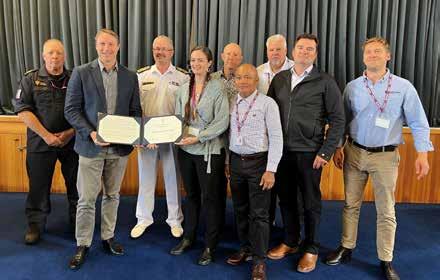
What and how much equipment do you have, where is it located, what’s safe to use, is it available, is it fit for purpose.
It’s a straightforward set of data that any military unit needs to have a grip on. Now a dedicated team, based at Devonport Naval Base, is providing that confidence for units.
The Maritime Equipment Group is a new sub-unit of the Defence Equipment Management Organisation (DEMO), falling under Defence Logistics Command. From its birth in 2019, its role is to provide inservice strategic management of Defence Force non-platform maritime equipment.
It sounds like a perfectly sound thing to do, and it is, but if you picked a unit of divers and hydrographers like HMNZS MATATAUA, you’re dealing with a lot of gear.
Which made MATATAUA the ideal unit to for the Maritime Equipment Group to prove its worth on.
The MEG team worked with Babcock’s Equipment Accountability Transfer Team to transfer and manage thousands of pieces of equipment into an inventory for MATATAUA.
This included reviewing expiry dates, maintenance plans and support, and checking safety manuals.
For their efforts, the team was recently presented with a Chief of Navy Commendation.
“Since the standing up of the Maritime Equipment Group, there have been over 1400 individual items successfully transferred to SAP management for MATATAUA alone,” says Chief of Navy Rear Admiral David Proctor. “But the work produced by the MEG team has enhanced the safety and assurance for the entire Navy system, not just HMNZS MATATAUA.”
Commander Trevor Leslie, Commanding Officer of MATATAUA, described it as “a weight off our shoulders” for his unit.
“MATATAUA is based on small, deployable, mission-based detachments that use a wide range of equipment and tools to achieve its objectives. Managing the countless pieces of equipment held and operated by MATATAUA is a highly complex problem, especially as MATATAUA operates differently to its counterparts, utilising many technical, life-saving and supporting systems.”
“It gives me so much confidence now that I can trust the equipment,” he says.
Logan Bax, Equipment Management Group Leader, says his team were very honoured to receive the recognition.
“As well as ships, there is a lot of important supporting equipment that requires a large amount of expertise and attention. This is where we come in. Units are busy in day to day operations, while we’re ensuring they have the right equipment available at the right time, for the right effect.
“This includes supporting the capability branch with introduction into service ensuring all of the ILS (Integrated Logistics Support) elements are provided for, while providing maintenance scheduling, technical support, contract management, documentation, withdrawal from service, and forecasting rolling capability refresh replacements.
“There’s a lot of churn in units, with people posting out or moving in, while we remain to provide stability, a consistent approach, and continuous improvement utilising the ISO55001 asset management framework.”
MATATAUA was a challenge, but a rewarding one, he says. “This was achieved through a lot of hard work and engagement between the MEG and MATATAUA staff, with plenty of support from DEMO senior leadership, and commercial vendors – a real team effort,” says Mr Bax.

There’s a legacy of top cadet coxswains seeking a career in the Navy, and Petty Officer Cadet Shaydon Steele looks like being the latest.
POCDT Steele, 17, is the latest recipient of the Elizabeth Smith Award, presented to the most outstanding cadet on the annual Cadet Coxswain Course. The course, which provides Sea Cadets with the knowledge of skills required to take charge of boat during sailing activities, was held at Tamaki Leadership Centre, Whangaparāoa, over a week in January.
Former Sea Cadets and past winners of the award were at the presentation. Midshipman Leighton Tanner (Minister of Defence Sword of Honour, currently with HMNZS TE KAHA); Midshipman Georgia Bilby
(currently Naval Reserves Common Training) and Able Hydrographic Systems Operator Renee Mullins (HMNZS MATATAUA) (pictured).
POCDT Steele joined Sea Cadet unit TS CHATHAM in Tauranga in 2019. “I’ve wanted to join the Navy since I was young,” he says. “The whole way of life appeals to me, and I love the water.” He got involved in Scouting at an early age before discovering Cadet Forces. CHATHAM has about 18 cadets.
“The course was such good fun,” he says. “A lot of theory to reinforce what I’ve learnt, then long days out on the water. We were up at 6.30am, breakfast, one lesson, then off to the boats.”
The award was presented to him on the last day of the course. “Definitely a big surprise and it was awesome seeing the past recipients. It’s my plan as well to apply – I’m hoping to join next year.”
He’s talked to recruiters who have come to CHATHAM parade
nights. “My mum is fully on board and my grandmother is really close in my life. She was the first one I told about the award.”
He’s just started his first full-time job since finishing at Tauranga Boys’ High School, and will stay at CHATHAM until he goes into the Navy. His mother is currently training to become a Cadet Forces leader.
“CHATHAM has a good buzz. People are happy to be there, and the big indication is how much laughter there is before the night starts. Everyone arrives earlier to have a chat.”
The roles offered with No. 6 Squadron and their Seasprite Maritime Warfare helicopters have a lot of appeal.
“I was lucky, during some courses, to go to RNZAF Base Auckland. It was pretty hard when you’re on parade, keeping your eyes down and not looking up at the Seasprites. I definitely want to be working with them.”
The Elizabeth Smith Trophy is a 50 cm bronze statue of a sailor, presented to the Sea Cadet Corps in 1973. Elizabeth Smith was a former President of the Wairarapa Navy League who was deeply impressed with the Sea Cadet Corps’ work with youngsters.




A New Zealand Defence Force contingent enjoyed a welcome return to Auckland’s Pride Festival last month. Twentyfive Defence Force personnel, uniform and civilian, joined in a colourful celebration as part of the Rainbow Pride Auckland Parade on Ponsonby Road to celebrate the diversity of New Zealand’s LGBTTQIA+ community.
In 2019 the New Zealand Defence Force celebrated Pride 25, marking 25 years since LGBT+ personnel were welcomed to serve openly in the NZDF. It was also the first time a Chief of Defence Force had marched in a Pride Parade.
Photos: LAC Andy Jenkins


Congratulations
13 February 2024
LT Bradley AMOS
ENS Jess ANDREWS
ASCS Elijah BELTON
AWTR Ivan BIBIKOV
ENS Ben BRYANT
LT Alfie BUTLER
AEWS AJ CALLANDER
ENS Ben CANTON
LTCDR Leonie CARTER
SLT Joshua CLAPP
POSCS Victoria CLEMENTS
AEWS David COLLIER
SLT Henry COLLINS
ACT Katie COLLIS
ENS Naya COOK
POMEDIC Kesia COUTTS
WOMT(L) John CURTIS
ENS Hamish DUGGAN
LTCDR Ben FAIRWEATHER
LTCDR Brett FITZGERALD
SLT Aidan FOLGER
SLT Jessie GAIR-AH SIU
ENS William HARRIS
AEWS Jack HERLIHY
LT James HUDSON
SLT Jett HUNIA
A/POCH Bradley JAMES
AEWS Quinton JONES
ENS Zach JUDKINS
ENS Cambell JULIAN
A/CPOMED Sarah KAULIMACLIFFORD
ENS Samuel KING
SLT Hannah LARSEN
A/LMT(P) Kerimay MALCOLM
POCWS Hayden MAXWELL
ENS Quin MCCLEAN
SLT Sam MCDONALD
A/LT Shannen MCERLAIN
WOCH Mark MIDDLEMISS
LT Elliott MILLAR
CDR Louis MUNDEN-HOOPER
2024 CATEGORIES
Nominations Open Tohu Awards
LT David OH
ENS James OWENS
ENS Lewis PANGALILA
ACT Puti POMARE
AMT(P) Ashanti – Paige RANAPIA
POCWS Dale RICE
SLT Floyd ROSS
LT David ROUT
POLSS Laken SKIPPER
POSCS William SMART
ASCS Ashley THOMAS
SLT Charli THOMAS
SLT Dirk VAN WIJK
ENS Emma WALKER
POCH Jesse WANA
ENS Brooke WILLIAMS
WOCH Hayley WILTON
LT Haylee WITIKA
ENS Renee WOODWARD
SLT Joseph YOUNG
SUBMIT NOMINATIONS:
Chain
QUERIES? secretariat@desc.govt.nz
01
Job Title and description:
Commander Logistics (COMLOG), Defence Logistics Command. Officially the organisation undertakes the delivery of logistics support/ supply chain management (everything you can think of), engineering (maintenance, repair and overhaul) and shared services (accommodation, messing/dining) required to maintain and sustain the Defence Force operations and capabilities –just like the Ghost Busters, “Who you gonna call”!
Date Joined RNZN:
02
03
04
13 March 1985 as an Ordinary Writer, Commissioned in May 1990
First ship posted to: HMNZS MONOWAI.
Best deployment and why:
1986–1987 HMNZS MONOWAI, Women at Sea Pilot Study, being part of the Navy’s journey integrating women into the seagoing environment.
2000–2002 Supply Officer HMNZS TE KAHA – I felt as if I had come full circle.
2004–2005 United Nations Truce Supervision Organisation – Unarmed Military Observer in Lebanon and Israel. Working in the most complex region (and my favourite region) in the world with 28 other nations.
Hometown:
05
06
07
North Shore, Auckland.
High School:
Westlake Girls High School; NZ Force School Sewbawang Singapore; NZ Correspondence School.
Favourite book:
Too many to name, but I have three on the go at the moment – Untouchable Girls – Topp Twins; Assad: An under estimated Tyrant and Merchant of Terror and Feminism in Foreign Policy – Susan Markham.

Favourite movie:
08
09
10
As a child Chitty Chitty Bang Bang, as an adult anything with Julia Roberts, Richard Gere and Chris Hemsworth.
Favourite album:
Hey Jude – The Beatles.
Favourite song:
Hey Jude – The Beatles, I am Woman – Helen Reddy.
Favourite holiday destination:
11
12
13
I don’t have one – I just love travel and holidays.
Outside of work, what's the one thing you enjoy doing?
Spending time with my extended family, and close friends.
What's something about you that not many people know?
Snakes don’t bother me but I hate eels and worms.
14
15
A person that taught you a valuable life/Navy lesson… and the lesson was?
My Mum – to be compassionate, my Dad – to treat everyone with respect. Dame Catherine Tizard – try to be the best you can be, but don’t take yourself too seriously.
How would you describe the Navy in 10 words or less?
Amazing people, sometimes frustrating policies and practices, challenging, rewarding, unlimited possibilities.

•
•
•
•
•
Check out the Defence Loans and Banking package through the Police Credit Union scan the QR code or go to policecu.org.nz/nzdf-pcu/